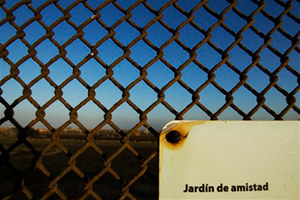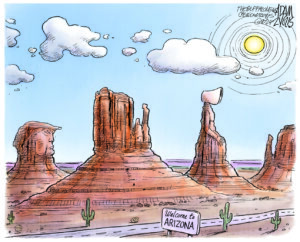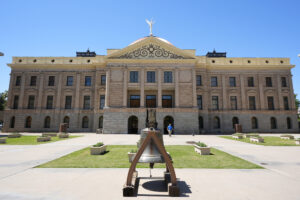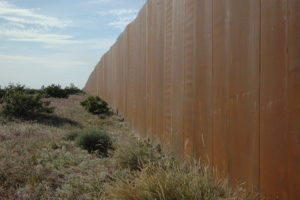New Year’s Call for a Border Reboot
In light of a recent murder, and considering that we are about to ring in a new year, I think the time has come to reframe the border discussion.
I recently moved to Arizona and the reaction I got from various friends was just as provincial as the one I got 20 years ago for moving to Los Angeles from New York. Then it was: “What’re you gonna do — spend your life in a hot tub?” “Hope you don’t start putting ‘dude’ at the end of every sentence.” Or, “Why — you wanna write screenplays?”
Actually, my East Coast compadres had a point. While in California, I did while away many hours in a hot tub. And I was known to interject “dude” in sentences (and nowadays, I continue to roll out “awesome” whenever I feel like it, which is often). Furthermore, yes, I confess — let me off the rack, for the love of God — I’ve written screenplays — sometimes while soaking in a tub with a dude (which is what I was doing shortly before I moved, although actually I was working on a book).
If my fellow citizens want to take these things personally, as a rejection of everything they stand for, the very thing they have spent years cultivating their identities around, well, as we all know, it’s a free country, and that is their right.
Now consider the reactions to my move to Arizona: “Oh, I see. You must be in favor of SB1070” (the state’s bill regarding immigration). Or “How could you live in the place where they turned down Martin Luther King Day?” (Courtesy Sen. John McCain, 20 years ago; a position since reversed). Or how about “Jan Brewer is on you” (the Arizona governor is the poster girl for SB1070). And finally, there was this: “Why? Are you planning to shoot Mexicans?” (a reference to lock and load groups that massed on the border; incidentally, I hear they were financed by people in Southern California).
Unlike my brothers and sisters on the Atlantic Seaboard, my Pacific posse doesn’t even have a point. By their own reasoning, they should flee California immediately. In fact, why some of them even considered being born there is beyond me. I mean, this is the state that passed Prop. 13 (which cut property taxes in 1978, leading to an ongoing crayon shortage in public schools — the least of the lack of supplies and services). It also enacted Ronald Reagan Day (Feb. 6). And let’s not forget that Orly Taitz lives there — you know, the Orange County lawyer/dentist/real estate agent who is also the Obama birther queen. I mean, how can people share a fault line with someone who believes the president “is the most dangerous thing one can imagine, in that he represents radical communism and radical Islam,” and who, quite interestingly, was not herself born in America, for crissake, and in fact is from Moldova? I mean, what is Moldova anyway — some kind of breeding ground for people who want to overthrow the U.S. government?
The idea that I should drive, fly or hike around rather than through a state that has the Grand Canyon because an election year measure is offensive is not part of my DNA. In fact, not coming to Arizona is a bad idea for everyone (actually, strike that; it’s a bad idea for most people), and that doesn’t mean Gov. Jan Brewer is my BFF or that I endorse one-way nuclear trip wires on the border.
However, the border should not be wide open. Do you let in everyone who knocks on your door? If someone rings your bell and then proffers a pamphlet that quotes Ephesians and bears the phrase “lamp unto my feet,” don’t you usually ignore them because they don’t have the right password? (Actually, those are the only people I let in, but that’s another story.)
The point is this: In the few months that I’ve been living in Arizona, I have found that the situation on and near the dividing line between Mexico and the United States is more complicated than those who have flamed me for setting up shop here would like to believe. In fact, it’s what I’ve always suspected, but try saying that while everyone else is shouting about the reconquista. In light of something that just happened, and considering that we are about to ring in a new year, I think the time has come to reframe the border discussion.
On Dec. 15, Arizona Border Patrol agent Brian A. Terry was reportedly gunned down in a shootout with bandits who prey on illegal immigrants traversing a violent smuggling corridor near the town of Nogales. Although there are now rumors swirling around the incident due to a news blackout, the manner of Terry’s death has been confirmed by Homeland Security chief Janet Napolitano.
Not unlike Gov. Brewer and others, Napolitano criticized the feds when she was Arizona’s governor for not doing enough to stop border violence, as Tim Vanderpool reported in the Tucson Weekly several years ago. At the time, there was growing concern about the desert bandits who haunt the old conquistador and Indian trails that immigrants are still following today. These bajadores often coalesce in the form of “rip crews.”According to a report by Brady McCombs in the Arizona Daily Star, Terry was part of a SWAT-like team called BORTAC, which was targeting one of these crews. BORTAC is part of Border Patrol’s “hunter and savior” mission, which stops people from crossing the border illegally but also rescues immigrants in trouble and monitors the bandits who regularly rob and assault the men, women, and children who are making the treacherous march to El Norte in search of a better life.
“Mexican drug-smuggling organizations have started using bandit crews to police their routes,” writes McCombs, “ensuring that competitors don’t use their hard-earned corridors, often stealing the loads. They operate all along Arizona’s international border, but the canyon-filled corridor west of Interstate 19 where Terry was killed has been a hot spot for bandits for years. In 2007, there were two fatal shootings involving bandits in the area.” (For a longer list of violent incidents involving bandits, illegal immigrants and federal agents, click on the Arizona Daily Star link above).
There are two types of border area bandits operating today, Lt. Raoul Rodriguez of the Santa Cruz County Sheriff’s Department tells McCombs. This includes crews that try to steal drug shipments and crews that assault and rob immigrants. “The crews consist of three to five men, dressed in dark clothes or fatigues, wearing ski masks, and carrying assault rifles or handguns,” he continues. “Groups that target illegal immigrants will usually pop up close to the border, demanding money and valuables and warning the people that they will kill them if they look back. Assaults and sexual assaults are commonplace. Crews that rip off drugs usually do it farther north, often 15 to 30 miles north of the border.”
At the moment, the FBI is investigating the killing of agent Terry, and here’s what is known so far: Apparently, he was shot in the back during a gunbattle. Four men have been arrested; their names have not been released, but they reportedly are not American citizens. A fifth suspect is on the run, perhaps heading toward Phoenix, Mexico, or just plain west.
As columnist Hugh Holub writes in the Tucson Citizen, the lack of additional information is fueling all manner of speculation in chat rooms and local media, from the idea that Terry was shot by friendly fire to the belief that BORTAC wasn’t properly armed.
Hanging over it all is the ever-present question about whether more border violence is coming.
“It’s not a smart move to engage law enforcement the way they do in Mexico,” Lt. Rodriguez tells the Arizona Daily Star. But Sgt. Gilbert Dominguez, a supervisor of the Pima County Sheriff’s Department’s border crimes unit, figures that there will be more shootouts with bandits. And another official predicts a major violent event within a year, involving Mexican drug cartels and U.S. law enforcement on this side of the border.
Meanwhile, for the bajadores on the trail, there is plenty of swag.
It seems to me that the men and women who place themselves between those who are coming here for a new life and those who would rob, rape, or kill them are engaged in a noble calling, dealing with the day to day repercussions of forces that are so tangled and twisted that it may take the Second Coming to sort them out.
What Brian A. Terry did, and what many other unsung deputies across the border are doing, gives the lie to the perception that people in Arizona don’t care about people who weren’t born here. And please note: This is not a hall pass for la migra, whose transgressions have been covered extensively in many other venues. To reiterate, I’m asking for a reconsideration of what’s playing out on our southern border, one that acknowledges the complexities of law enforcement — and life — on a line in the sand.
As Bill Broyles and Mark Haynes write in their new book “Desert Duty: On the Line With the U.S. Border Patrol,” those who serve “are common folks doing an uncommon job. Like police work anywhere, days of humdrum patrol and investigation are interspersed with moments of fear and heroics. Shots have been fired here, but the real count is in persons rescued from heat and fatigue, aliens apprehended, and tons of drugs confiscated. There is a toll of human life. Hundreds of aliens are known to have died in this crossing, but the total is unknown. Plane crashes have killed three Border Patrol pilots and an agent on duty in the region [in this case, the Yuma sector], and four ground agents have died, two in car crashes, one run down by a smuggler fleeing to Mexico, and one drowned as he attempted to save aliens caught in the swirling Colorado River.”
If there’s one thing we know about the border, it’s that people will not stop trying to cross it. Whether and when they merit citizenship is another question. Until that’s resolved, it says a lot about our country that some of us are dying to save those who are entering without papers, illegally, in the dark, over fences, through tunnels, barefoot, bleeding, snake-bit, penniless, hungry, thirsty, for hire, for rent, scheming, dreaming, conniving, no habla — and I’m not ashamed in the least for living here.
(P.S. For an excellent portrayal of the border conflict, including the history behind it, who’s crossing and who’s not, how various locals view it, and what’s being done about the impact on the environment, please see this article in the Sierra Vista Herald.)
Deanne Stillman’s latest book is the widely acclaimed “Mustang: The Saga of the Wild Horse in the American West,” a Los Angeles Times “Best Book ’08” and winner of the California Book Award silver medal for nonfiction. Her book includes an account of the 1998 Christmas horse massacre outside Reno, Nev., as well as the story of Bugz, the lone survivor of the incident. Her previous book was “Twentynine Palms: A True Story of Murder, Marines, and the Mojave,” the cult classic which Hunter Thompson called “A strange and brilliant story by an important American writer. It’s now out in a new, updated edition. Her work appears in the Los Angeles Times, Slate, Orion, National Review Online and other publications and is widely anthologized. Her plays, including “Star Maps,” have won prizes in theater festivals around the country. She is currently writing “Mojave Manhunt” for Nation Books, based on her Rolling Stone piece of the same name. Follow Deanne Stillman on Facebook.
Your support matters…Independent journalism is under threat and overshadowed by heavily funded mainstream media.
You can help level the playing field. Become a member.
Your tax-deductible contribution keeps us digging beneath the headlines to give you thought-provoking, investigative reporting and analysis that unearths what's really happening- without compromise.
Give today to support our courageous, independent journalists.






You need to be a supporter to comment.
There are currently no responses to this article.
Be the first to respond.